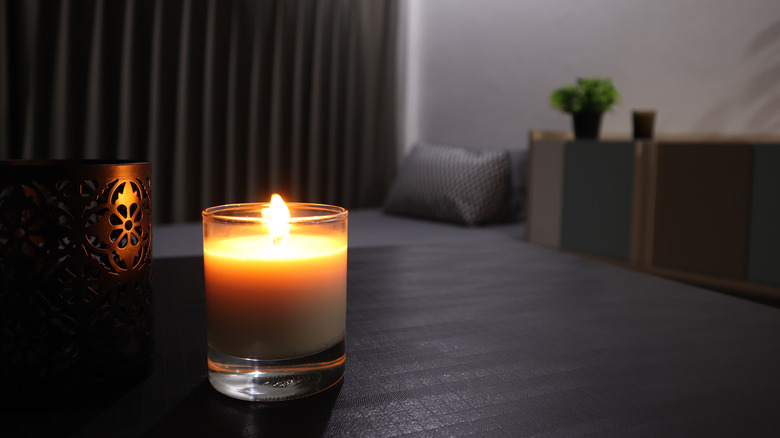Why Burning Scented Candles Could Be Hazardous To Your Health
Scented candles are a favorite household accessory for many, providing a relaxing effect through aromatherapy and a cozy vibe thanks to their flickering light. They can also mask unwanted smells in the home with their fresh, floral, musky, woody, or fruity scents.
So it's no surprise that candles are big business. Retail sales of candle products are estimated at approximately $3.14 billion annually in the United States, according to a 2013 study (via National Candle Association). Most of those sales — 35% — take place during the winter holidays, and it's estimated that U.S. candle fans have more than 10,000 scents from which to choose. All that candle consumption adds up to more than 1 billion pounds of wax being used each year nationwide.
However, have you ever stopped to think that, as you're burning your favorite candle for hours upon hours, it's not only filling your home with scent but chemicals as well? Depending on what your candle is made of, it could pose a health risk to you and those who live with you. Keep reading to find out why burning scented candles can be hazardous to your health.
Candles emit chemicals when they burn
The majority of affordable candles on the market are made using paraffin wax, which is a byproduct of petroleum. Scented candles made with paraffin wax can have a negative impact on air quality because they emit volatile organic compounds (VOCs) as they burn. The Environmental Protection Agency defines VOCs as "any compound of carbon, excluding carbon monoxide, carbon dioxide, carbonic acid, metallic carbides or carbonates, and ammonium carbonate, which participates in atmospheric photochemical reactions." Some of the VOCs emitted when candles burn include acetone, benzene, and toluene, according to a 2009 study, which have been deemed carcinogens.
Inexpensive candles also typically use synthetic fragrances to make them smell good. The problem is that they are made of potentially harmful chemicals, including formaldehyde, alcohol, and esters. These synthetic fragrances can cause unwanted health reactions, according to environmental pollutants expert Anne Steinemann, who acts as the chair of sustainable cities at the University of Melbourne. "I have heard from numerous people who have asthma that they can't even go into a store if the store sells scented candles, even if they aren't being burned," she says via HuffPost. "They emit so much fragrance that they can trigger asthma attacks and even migraines."
Don't ditch your candles just yet
However, don't toss all your scented candles ASAP. "There's conflicting evidence in the literature addressing the question of toxicity in candles," says Mary Brummitt, N.P., a primary care provider from One Medical (via Shape). While there's plenty of information available about the dangers of scented candles, other studies show that, when used under normal circumstances, scented candles don't pose a significant health risk. Generally, the consensus seems to be that the quantity of VOCs produced when burning candles isn't high enough to have any significant health effects, though they may still cause irritation in some people.
While scented candles may not have an immediate negative effect on the average person, there are still precautions you should take. Like everything in life, it's important to use moderation when burning candles. "For a person who lights a candle every day for years or just uses them frequently, inhalation of these dangerous pollutants drifting in the air could contribute to the development of health risks like cancer, common allergies, and even asthma," says Ruhullah Massoudi, a chemistry professor from South Carolina State University (via HuffPost).
When shopping for candles, look for those made with all-natural materials. Candles made of beeswax or soy wax emit fewer VOCs and are safer to burn in your home. Avoid burning candles in small, confined spaces for long periods of time, and consider cracking a window to improve ventilation when possible.


